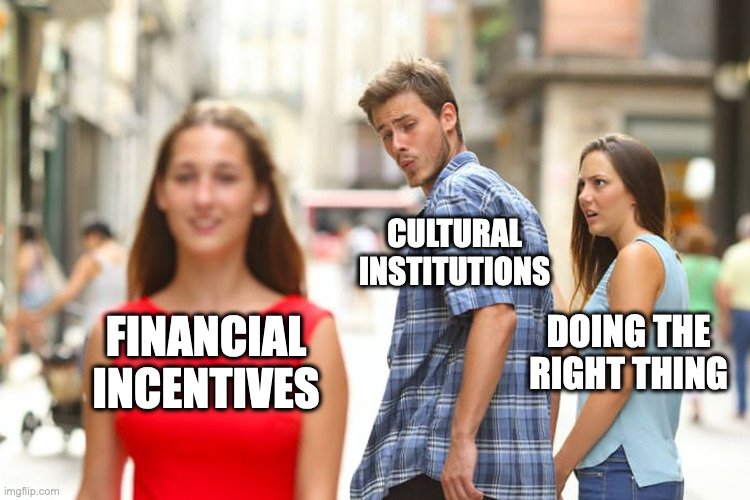To truly implement sustainable solutions into your work, you must have real, achievable incentives.
A little over a week ago, I attended a prescient event in New York hosted by the Responsible Art Market Initiative which presented panels on two of the major topics of our time: NFTs and Sustainability in the stark white, overhung walls of the below ground Phillips auction house building on Park Avenue.
The NFT panel piqued my interest because it shows a continued interest and relevance to the topic that a few months ago saw a market collapse and presumed ending of the “fad”. This panel suggests they still have a role to play. That said, I have spoken enough about NFTs (for more about NFTs, go here) and will not retrace those footsteps.
On the other hand, the distinguished panelists made some very important points on the topic of sustainability. Upon later reflection, however, I came to realize that what they described ultimately lack teeth because their solutions lack incentives. This explains why, despite years of discussion about the topic, years of feeling bad about about disposing an exhibition’s worth of crates after one use, years of diamond-medallion-air-miled administrators, years of unnecessary couriers, and years of 70 degrees/50% relative humidity nothing has changed.
I did not make the rules, but here we are.
The presenters included Laura Lupton, an art and climate consultant and co-founder of Galleries Commit, Nicole Bouchard Tejeiro, a senior director at Crozier Fine Arts, and Sophie Scheerlinck, former CEO of the TEFAF art fair and current COO of the Independent Art Fair. Nanne Dekking, the CEO and founder of Artory moderated the discussion. All distinguished in their accomplishments in the field.
I truly appreciate a few key points that were made. First, Ms. Bouchard Tejeiro brought up the “low hanging fruit” that is the vast use of resources deployed to maintain high climate standards. I fully agree as many believe the energy generated to maintain those standards actually emits the most greenhouse gas into the atmosphere.
Additionally, Ms. Lupton’s impressive record advocating for sustainability initiatives through her various organizations has connected many related institutions that collectively offer resources about art and climate initiatives. She and her related organizations are primary resources on sustainability and the art world.
Ms. Scheerlinck, pointed out the difficulty of running art fairs in sustainable ways and critically pointed out that operating in ways that cause less environmental damage often costs more. She used an example of cleaning, storing, and reusing the carpet laid for the fair which literally comes at greater expense than disposing and replacing the carpet during the next iteration.
This point importantly describes why so little has changed on a scale that causes a significant impact. If we rely on institutions to merely “do the right thing”, nothing will change – and it has not to date – at the necessary scale to achieve the desired result, fewer emissions, because it actually costs more to do the right thing.
I will keep repeating that we can have an “economic eclipse” where sustainability, economics, and collections care align for improved practices. Options like the oft-proposed-still-fossil-fuel-dependent sea freight solution which is so wildly impractical (days or weeks at sea) and risky (ask any insurance underwriter what they think of sea freight) that we should discourage it for all but the most necessary shipments. Jeopardizing the care of the object should not be the first option for reducing fossil fuel emissions in other words. Why put the burden of reducing emissions on the objects in the collection we swear to protect?
I would like to see calls for renewable energy sources for institutions, less staff travel, and longer exhibitions in these discussions (to name but a few) because they benefit the objects as well as the environment and the bottom line. If we do not offer incentives beyond “it is the right thing to do”, we will not make a dent in the problem. Positively speaking, we have many options that can help on three different fronts.
In my Cognitive Dissonance series, Part 1 and Part 2, I offer many more economic eclipse options that allow us to leverage object demand for loans to achieve more sustainable practices. Use your loan contract to make demands, for example. Use higher loan fees to invest in sustainability initiatives. Add a sustainability charge to the sale of your works in your gallery that goes toward legitimate offsets, like that which Galleries Commit features on its website, for all the art fairs you attend. In fact, during the presentation, they pointed out that the majority of collectors (and NOT dealers) felt that the issue of sustainability mattered significantly. Regardless, these are but a few quick changes that you can implement now that do not require upending the entire industry as we know it. Money defeats feeling good about yourself every time; therefore, you should use that to your advantage.
The program ended with my hand still in the air ready to pose some of these questions to the panel; therefore, I will distill my point here: whether we choose to act for financial or for moral reasons, we need to create the right incentives to achieve the desired effect. I continue to beg everyone to sing from the economic eclipse hymn sheet because no one else has offered a win-win-win situation.



